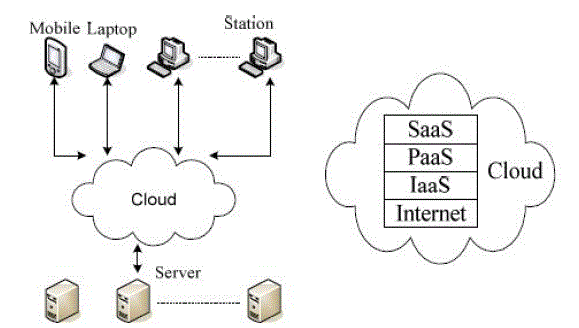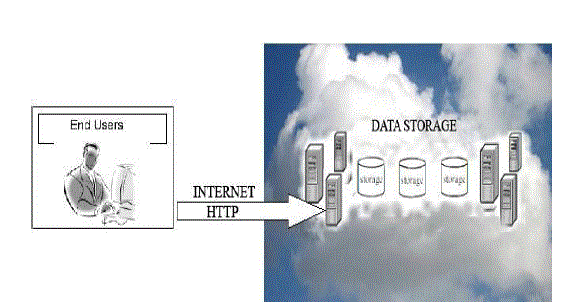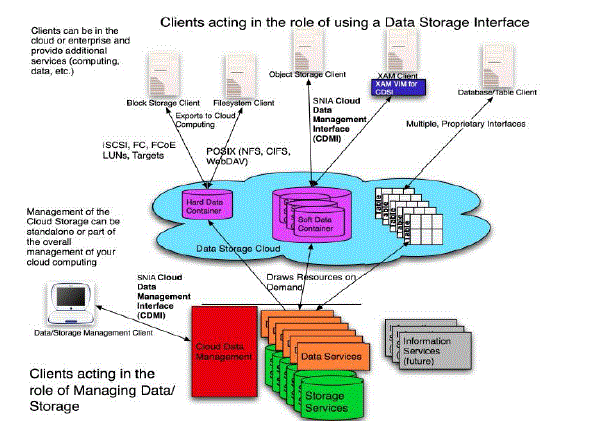Keywords
|
| Cloud computing; cloud storage; service; architecture |
INTRODUCTION
|
| Cloud computing is one of the strategic technologies that is rapidly developing in trend. It has been attracting enterprises and individuals. The cloud computing service model involves the provision, by a service provider, of large pools of high performance computing resources and high-capacity storage devices that are shared among end users as required [1]–[3]. |
| Through cloud computing user can run their applications and store their data’s in the cloud. Cloud Service providers are establishing data centers for hosting cloud computing applications in various geographic locations. There are many cloud service models, but generally, end users subscribing to the service have their data hosted by the service, and have computing resources allocated on demand from the pool. The service provider’s offering may also extend to the software applications required by the end user. To be successful, the cloud service model also requires a high-speed network to provide connection between the end user and the service provider’s infrastructure. |
| Users can enjoy the advantages of cloud computing services such as redundancy & reliability in case of any site failures. It is also attractive due to per-use pricing and elastic scalability, providing a significant advantage over the typical acquisition and deployment of equipment that was previously required. |
| Cloud computing introduces virtual computing as the enduser is not essentially building his application in his personal system. Service providers are the administrators managing these virtual environments. This gives rise to further challenges such as the intelligent allocation of physical resources for managing competing resource demands of the users. |
| Cloud storage is an essential part of cloud computing. The mass storage environment is provided by different servers of service providers. From individual point of view, its financially advantageous as its cheaper than dedicated physical resource. Also, secure as redundancy is maintained and managed in multiple systems by service providers. |
CLOUD COMPUTING SERVICES
|
| The Cloud Infrastructure Service or the Infrastructure as a Service (IaaS) provides IT infrastructures as a service over computer networks. The Cloud Platform Service or the Platform as a Service (PaaS) delivers computing platforms as a service to sustain the cloud applications. The Cloud Application Services or Software as a Service (SaaS) delivers software as a service over the network, allowing users to use applications without having to install and run software on their own computers |
| IAAS delivers computer infrastructure - typically a platform virtualization environment - as a service. Rather than purchasing servers, software, data-center space or network equipment, clients instead buy those resources as a fully outsourced service. Suppliers typically bill such services on a utility computing basis and amount of resources consumed (and therefore the cost) will typically reflect the level of activity. IaaS evolved from virtual private server offerings. Examples are BT, Telstra, T-systems (ITaaS), Flexiscale, AWS: EC2. |
| PAAS delivers a computing platform and/or solution stack as a service, often consuming cloud infrastructure and sustaining cloud applications. It facilitates deployment of applications without the cost and complexity of buying and managing the underlying hardware and software layers. Examples are Google app engine, Mosso, AWS: S3, Force.com, Navitaire. |
| SAAS deliver software as a service over the Internet, eliminating the need to install and run the application on the customer's own computers and simplifying maintenance and support. Key characteristics include: |
| • Network-based access to, and management of, commercially available (i.e., not custom) software |
| • Activities that are managed from central locations rather than at each customer's site, enabling customers to access applications remotely via the Web |
| • Application delivery that typically is closer to a one-to-many model (single instance, multi-tenant architecture) than to a one-to-one model, including architecture, pricing, partnering, and management characteristics |
| • Centralized feature updating, which obviates the need for downloadable patches and upgrades. Examples include CRM, Financial planning, Human resources, Word Processing; Commercial services like: salesforce.com, emailcloud |
| Advantages of the above services: |
| • Pay per use |
| • Instant scalability |
| • Security |
| • Reliability |
| • APIs |
| • Reduce infrastructure management responsibility |
| • Allow for unexpected resource loads |
| • Faster application rollout |
| Cloud storage is a model of networked computer data storage where data is stored on multiple virtual servers, generally hosted by third parties, rather than being hosted on dedicated servers. Hosting companies operate large data centers; and people who require their data to be hosted buy or lease storage capacity from them and use it for their storage needs. The data center operators, in the background, virtualize the resources according to the requirements of the customer and expose them as virtual servers, which the customers can themselves manage. Physically, the resource may span across multiple servers. |
| Cloud storage is built on the cloud computing environment, so the hierarchical structure should be consistent with the hierarchical structure of the cloud. The storage object is still in the form of files and directories. The only difference is how to implement the system to satisfy users' increasing requirements. |
| Data centers provided by service providers are managing the data storage. There exists different kinds of storage services to meet the requirements of specific forms such as digital data, images, web mails … so; a huge amount of storage environment is hosted, accomplished by different data servers. |
| A central storage control server would be present to manage all these database storages. Cloud Storage correlate with data Storage nodes spread over a wide geographic area. Storage node consists of Storage devices and data pooling. Cloud Storage System manages and handles coordinately dispersed Storage node. |
| Various types of storage cloud services and applications are presented ranging from web based word processors and email clients based on GFS, to http based online storage like S3, to mountable block storage like EBS for EC2, to keyvalue storage like Dynamo and SimpleDB. The two storage infrastructures are block/file storage and record storage. |
| Examples of these storage infrastructures include Google File System (GFS), Amazon S3 and EBS, Hadoop Distributed File System (HDFS), CloudStore (formerly KFS), Google BigTable, Amazon Dynamo and SimpleDB |
| Block level refers storing data into different single hard disk in order to get a larger single read and write bandwidth. It’s helpful in fast read write of single data but handling mass file storage is difficult. File level storage stores in terms of files in hard disk. The record storage level provides simple and scalable key value storage service. Big Table and Dynamo are the leading record storage infrastructure for cloud. They are designed for web applications and services which exhibit significantly different data access behavior than that of traditional application. |
| A simple working of would say client being connected to a data server via internet. Transaction happens like sending copies of files to data server on cloud. Data server records the information and also makes duplicates to rescue from threats/failures. Whenever client wants to retrieve the data, he can use web-based interface for that, while server sending back the files to client following him to manipulate information on the data server. |
A SIMPLE MODEL
|
| Cloud storage is of very much importance in cloud computing. It has to satisfy the growing needs of enterprises or individuals. It needs to maintain features of scalability, reliability, availability, ease of use and effective management. The above model shows multiple cloud data storage interfaces supporting both legacy & new applications. Different applicants may need different set of services. |
| We are having pool of various resources which could be retrieved on demand. The interaction of the end-user with cloud is achieved through an interface as shown in figure. i.e., the SNIA Cloud Data Management Interface (CDMI). This is the interface that helps end-users solving their demand of manipulating their information on cloud. |
PROMISES, CHALLENGES AND BARRIERS
|
| Cloud computing users avoid capital expenditure on hardware, software, and services when they pay a provider only for what they use. Consumption is usually billed on a utility (resources consumed, like electricity) or subscription (time-based, like a newspaper) basis with little or no upfront cost earning a Minimized Capital expenditure. Users can access and manage their data from anywhere in world regardless of their location or what device they are using creating a Location and Device independence. Scalability via dynamic on-demand provisioning of resources on a fine-grained, self-service basis near real-time, without users having to engineer for peak loads. Performance is monitored, and consistent and loosely coupled architectures are constructed using web services as the system interface. |
| One of the most important new methods for overcoming performance bottlenecks for a large class of applications is data parallel programming on a distributed data grid. Other benefits of this approach are Utilization and efficiency improvement as resources are shared among users, low barriers to entry, shared infrastructure and costs, low management overhead, and immediate access to a broad range of applications. In general, users can terminate the contract at any time (thereby avoiding return on investment risk and uncertainty), and the services are often covered by service level agreements (SLAs) with financial penalties. |
| Dangers |
| • Disrupts Services. |
| • Theft of Information. |
| • Loss of Privacy. |
| • Damage information. |
| Vulnerabilities |
| • Hostile Program. |
| • Hostile people giving instructions to good programs. |
| • Bad guys corrupting or eavesdropping on communications |
CONCLUSIONS AND FUTURE WORK
|
| Cloud computing is a very vast area and is already changing the landscape of the computing industry. In fact it touches on just about every aspect of personal and business computing. Cloud storage being an essential part aims at preparing large scale data storage spaces, cloud storage platform reliability, continuity and security of the entire cloud storage platform and data storage activities management. |
| This paper would give an introduction to cloud computing, its services and a model to perceive information on cloud storage, finally the promises of cloud computing, challenges & barriers. |
| Future works would be to concentrate on managing cloud storage to ripe redundancy and to achieve high level of security. |
Tables at a glance
|
 |
| Table 1 |
|
| |
Figures at a glance
|
 |
 |
 |
| Figure 1 |
Figure 2 |
Figure 3 |
|
| |
References
|
- Open Cloud Manifesto. [Online]. Available: http://www.opencloudmanifesto.org/
- M. Armbrust, A. Fox, R. Griffith, A. D. Joseph, R. H. Katz, A. Konwinski, G. Lee, D. A. Patterson, A. Rabkin, I. Stoica, and M. Zaharia, BAbove the clouds: A Berkeley view of cloud computing,[Electr. Eng. Comput. Sci. Dept., Univ. California, Berkeley, CA, Tech. Rep. UCB/ EECS-2009-28, Feb. 2009.
- L. M. Vaquero, L. Rodero-Merino, J. Caceres, and M. Lindner, BA break in the clouds: Towards a cloud definition,[ SIGCOMM Comput. Commun.Rev., vol. 39, no. 1, pp. 50–55, 2009.
- Luis M.Vaquero,LuisRodero-Merino, Juan Caceres,Maik Lindner. A Break in the Clouds: Toward a Cloud Definition. ACM SIGCOMM Computer Communication Review, 2009,39(1):50-55.
- Wikipedia. Cloud computing .Retrieved from http://en.wikipedia.org/wiki/Cloud_computing,2010
- Jeffrey B.Layton.Cloud Storage Concepts and Challenges [OL], http://www.linux-mag.com/cache/7617/1.html,2010
- Storage Networking Industry Association.Cloud Storage for Cloud Computing, Jun.2009
- Network Computing magazine on months January, February & March 2010.
- Cloud computing basics. http://www.explainincomputers.com
- Cloud computing security. http://www.youtube.com
- Trusted computing. http://en.wikipedia.org
- Trusted Computing Group. https://www.trustedcomputinggroup.org.
- Issues in cloud computing. https://www.searchcloudcomputing.com
|